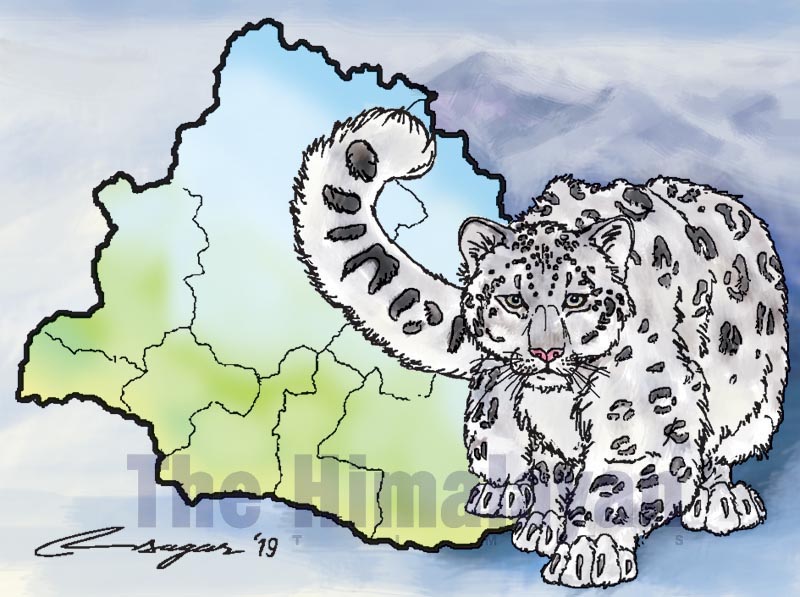Tradition meets modern science: In snow leopard conservation
With advanced science, increased understanding and concern of local communities towards the environment and informed leadership of the government, Nepal promises to be a global stronghold for the survival of snow leopards
About nine centuries ago, a monk meditating at the base of Zeborong Mountain—in Bhijer, current day upper Dolpa—found himself on foot, retracing snow leopard pugmarks. He had lost his mandala and assumed that the animal’s signs would lead him to his valuable. He ended up in Jumla, ruled by a distraught king, whose queen had been suffering from a seemingly incurable illness. The monk was not a medical practitioner, but upon the king’s insistence, he prayed for three days, and the queen was saved. As a reward, Nasar Gumba was established in Bhijer, as the local belief goes. Even at the dawn of the 21st century, snow leopards continue to be protected by their cultural entrenchments in our country. But in today’s anthropocentric society, snow leopards face many threats that demand urgent attention. With population estimates at 4,000-6,000, distributed across just 12 countries in the world, the future of this species hangs on a precarious balance. Efforts to save the species continue globally, and Nepal is a frontrunner.
This urgency brought us to Shey-Phoksundo National Park (SPNP) last month on the government’s mission to collar two snow leopards with satellite telemetry devices. Our research mission, led by the Department of National Parks and Wildlife Conservation (DNPWC), involved a team of around 20-25 individuals - local citizen scientists, SPNP staff, members of National Trust for Nature Conservation (NTNC) as well as WWF researchers.
Our selection of Samling Gumba—an 834-year-old monastery, located towards the south of Bhijer—as our expedition base camp was a product of periodical automated camera trap surveys. In May 2018, camera traps placed over 300 sq. km around Bhijer village had confirmed the presence of at least 14 individual snow leopards, indicating this region as a hotspot. Camera trapping was also conducted in September 2019 to identify current movement patterns of snow leopards before the team set out in mid-October. Given the pre-assumed density of the species in the area, we were enthused by the prospect of fulfilling our mission but dreaded disappointment—given the elusive nature of the species.
We arrived in Samling Gumba with a mixed bag of emotions and equipment, following ten days of travel and preparation. Operations ensued following a prayer ceremony, led by the head monk. We then oriented citizen scientists and SPNP game scouts on the objectives and methodology. From them, we learned about the landscape and movement patterns of snow leopards. But we were faced with a ‘needle-in-a-haystack’ situation: we had a total of 24 traps (less than 2 sq. feet each) distributed across 50 sq. kilometres.
Nonetheless, we leveraged our strategic advantage - combining existing knowledge on snow leopard ecology and movement with information from camera traps, we planned and placed the traps. Each of these traps was remotely monitored using radio transmitters at hourly-intervals.
The trap monitoring team mostly reported ‘all normal’, relaying that none of the traps had been activated. Occasionally, they reported changes in transmitter signals, triggering excited frenzies at our base camp, as a team prepared for visual verification of the activated trap site only to be greeted by disappointment. Most activations were caused by the abundant livestock that form a major livelihood source for the community or from non-subject wildlife. This cycle of wait, monitor, hope, false triggers and trap resetting persisted for about 15 days. Then, on the 16th morning, the farthest trap from our base was activated. A team sent for visual confirmation reported in loud whispers from the trap site, “A snow leopard has been captured, come quickly,” evoking a camp-wide cheer.
Everything moved really fast then. The entire team left from the camp, and trekked towards Bhijer village, descending further into and walking up the river valley, reaching the capture site. The animal was sedated, freed from the trap, examined for necessary data collection, collared, and released back into the wild. Before the release, our citizen scientist named the animal Zeborong, after the local Snow Leopard Conservation Committee in the region. The second animal, Samling Gumba, was trapped just two nights later.
Over the coming months, we will be monitoring the two animals and building an invaluable database on their home range, movement patterns, among other critical information that will aid in species conservation planning. Such research, although resource-intensive, is an important element in conservation. Similar research in Kanchenjunga Conservation Area and other parts of Nepal had earlier provided critical inputs to the country’s Snow Leopard Conservation Action Plan and the world’s first climate-smart Snow Leopard and Ecosystem Management Plan – Eastern Himalayan Landscape.
The traditions of various mountain communities continue to help snow leopards thrive in Nepal. With advanced science, increased understanding and concern of local communities towards the environment and informed leadership of the government, Nepal promises to be a global stronghold for the survival of snow leopards, in perpetuity.
Shrestha and Subba are researchers at WWF Nepal






